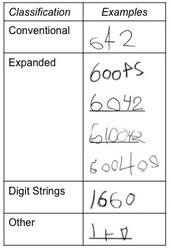Highlight
Beginnings of Place Value: How Preschoolers Write Three-Digit Numbers
Achievement/Results
Before they begin formal schooling, children are surrounded by written numbers, including written versions of large numbers. However, not much is known about their earliest ideas about how multi-digit numbers are written and the underlying place value principles. Characterizing these early ideas is important, because schooling must begin with what the child already knows and because understanding place value notation is major stumbling point for many children when learning how to add, subtract, multiply and divide large numbers.
New interdisciplinary research conducted by graduate student Lisa Byrge and Dr. Linda B. Smith of Indiana University Psychological and Brain Sciences, and Dr. Kelly S. Mix of Michigan State University College of Education, has characterized these early ideas. Byrge is a trainee in Indiana University’s “Dynamics of Brain-Body-Environment Systems in Behavior and Cognition” program, which is funded by NSF’s Integrative Graduate Education and Research Traineeship (IGERT) program. This study investigated how a sample of 172 4- to 6- year olds attempted to write 3-digit numbers in a dictation task, e.g. “Can you write six hundred and forty-two?” Because these children were too young to have had formal training in writing multi-digit numbers, we did not expect them to write them correctly. Instead, we were interested in what the structure of early errors might reveal about early ideas about the number writing system. Some children just produced scribbles or unrelated number strings when asked to write a number such as “six-hundred and forty two” but many 5- and 6- years produced attempts that suggest early – but not quite right – knowledge about how big numbers work. When asked to write “six hundred and forty-two” they wrote what might be called expanded forms such as “60042”, “610042”, “6042”, or “600402” suggesting knowledge about places and the role of 0.
Correct number writing was rare in the children studied. However, we found that 6-year-old boys were more likely than 6-year-old girls to write numbers correctly. Further research is needed to understand the cause and the meaning of this gender difference, but it may prove to be informative in understanding later gender differences in STEM fields. The prevalence of expanded writing as first (and unschooled) understanding of place value indicates that young children are trying to understand the number writing system on their own and provides a potentially useful starting point for teaching place value.
Address Goals
This activity addresses NSF’s strategic goal of Discovery by providing new insight into children’s early knowledge of multi-digit numbers and place value, which forms a foundation for their subsequent development of arithmetic skills. This activity addresses NSF’s strategic goal of Learning by identifying very earlier barriers to learning mathematics and suggesting educational strategies to address them. Learning place value is known to be very difficult for older children, and yet place value is a crucial foundation of mathematics. Effective instruction on place value must build on what children already believe about how multi-digit numbers work, and so characterizing these early ideas is a crucial first step to improving instruction.






